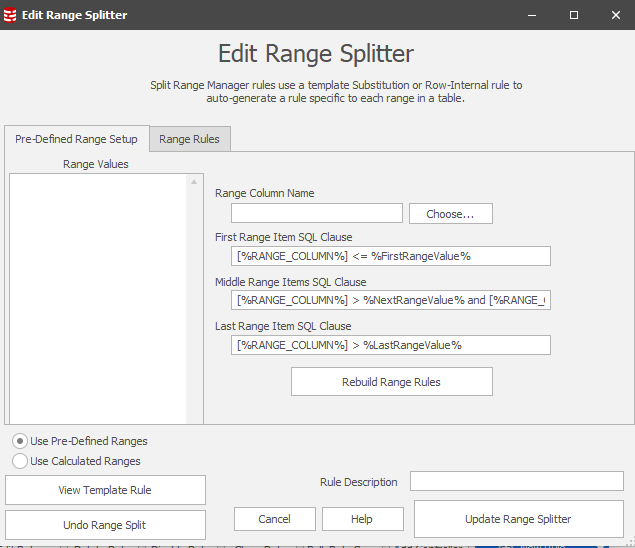Range Splitter Rules
Published 06 January 2020
Split masking operations into parallel streams - each of which can mask a subset of the data in the table. This type of parallelized masking can be problematic when done manually since a separate rule needs to be created for each range and the division of work enforced with a Where Clause. In addition, if a new range is added to the table, the manual method could not detect this situation and the new range could remain unmasked.
Split Range Manager rules are designed to address this issue. This type of rule uses a template (underlying rule) and defined ranges to operate on a specific ranges of the target table. These auto-generated rules operate in parallel and, hence, dramatically reduce the total time taken to mask the data in a ranged table.
Note: The Data Masker for Oracle software also contains a Split Partition rule which can split a rule into multiple parallel rules based on partition information.
Core concepts
Template
Range rules are not a standalone rules. They are created by converting one of these rules: Substitution, Row-internal, JSON masker, XML masker through Change manager tab. After conversion original rules are called the template and they can be viewed by pressing View Template Rule. You can always convert back to original rule through Undo Range Split button.
Note that while a rule is inside a Split Range Manager it is read-only and cannot be changed.
The rule ID is preserved between conversions.
Ranges
There are two ways of specifying ranges (this option can be changed with a radio button just below the tab area, and the panel shows different contents accordingly), each of them requires picking a column where you want to apply ranges.
Pre-Defined ranges
In pre-defined ranges you need to provided manually a list of split points.
Calculated Ranges
In calculated ranges mode you need to provide number of ranges and split points will be computed.
Rebuild Range Rules
You need to remember to press Rebuild Range Rules when you end defining ranges, It will rebuild underlying rule with split points using WHERE clause by demanded ranges. You can see them in Range Rules tab.
Advanced concepts
Range clauses
Range splitters require three clauses: first range item SQL tells Data masker how to find rows before the first range value; middle range item SQL clause tells Data Masker how to find rows between two sequential range values; and last range item SQL clause tells Data Masker how to find rows after the last range value.
Data Masker will always create rules to match rows before and after the provided ranges to ensure all data is masked even if new rows are added.





